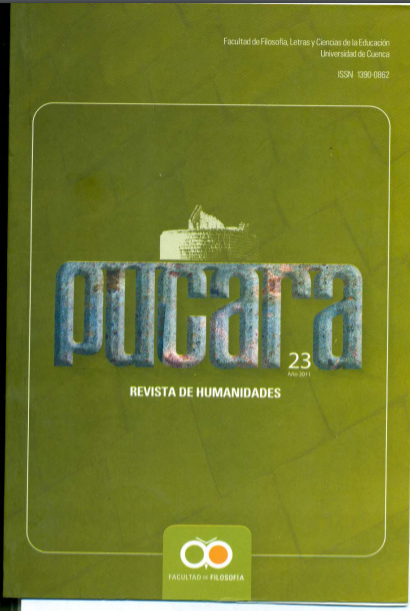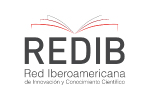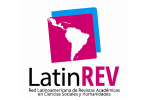The logos relapse into a myth and the salvific myth of European modernity
DOI:
https://doi.org/10.18537/puc.23.02Keywords:
logos, mito, Modernidad, críticaAbstract
This work refers to the transition from the myth to the logos,taking into account certain considerations of the Dialectic of the Illustration; however, it does not concentrate on a detailed analysis of its subject matter, but it departs from it to reflect on the transit of the logos to the illustrated myth of the reason within the historical conditions of a “discovered” America; also, it considers the hypothesis that the origin of the illustrated myth of the LatinAmerican modernity is articulated around the notions of reason, progress and salvation within the perspective of showing a possible “coincidence” between the Dialectic of the Illustration (Max Horkheimer and Theodor W. Adorno) and the Critic of the Modernity “myth” (Enrique Dussel).
Downloads
References
De Sepúlveda, G. “De la justa causa de la guerra contra los indios”.1492 El encubrimiento del Otro, Hacia el origen del “mito de la modernidad”de Enrique Dussel. La Paz: Centro de Información para el desarrollo,1994.
Dussel, Enrique. “Transmodernidad e interculturalidad (interpretacióndesde la filosofía de la liberación)”. Crítica intercultural de la filosofía latinoamericana actual. Madrid: Ediciones Trotta, S.A. , 2004.
Dussel, Enrique. “Europa, modernidad y eurocentrismo”.La colonialidaddel saber: eurocentrismo y ciencias sociales. Perspectivas Latinoamericanas.Buenos Aires: Consejo Latinoamericano de Ciencias Sociales, 2000.
Dussel, Enrique. 1492 El encubrimiento del Otro, Hacia el origen del“mito de la modernidad”,La Paz, Centro de Información para el desarrollo,1994
Echeverría, Bolívar. Vuelta de Siglo. México D. F.: Ediciones Era,2006.
Foucault, M. ¿Qué es Ilustración?, Daimon, Revista de Filosofía(7,5,18), Presentación de Antonio Campillo, Departamento de Filosofía yLógica, Facultad de Filosofía, Universidad de Murcia, 1993. Disponible en: http://revistas.um.es/daimon/article/view/13201Foucault, M.¿Qué es Ilustración? En Saber y Verdad Ilustración?, Madrid: Ediciones de la Piqueta, 1991. Disponible en:http://www.quedelibros.com/libro/41414/Que-Es-La-Ilustracion.html
Hegel, Jorge Guillermo Federico. Lecciones sobre la Historia de la Fi-losofía(Vol. III), México, D. F.: Fondo de Cultura Económica, 1995.
Heidegger, Martín: Was ist das die Philosophie?, Tübingen, 1956, ci-tado por Hernán Malo González, en Pensamiento filosófico, Volumen I,Quito: Corporación Editora Nacional/ Pontificia Universidad Católica delEcuador, 1989.
Herder, Johann Gottfried. “La idea de humanidad”. ¿Qué es Ilustra-ción?Madrid: Tecnos, S.A., 1999.
Horkheimer, Max y Adorno Theodor. Dialéctica de la Ilustración.Fragmentos filosóficos.Madrid: Editorial Trotta, S. A. ,1998.
Kant, Immanuel. “Acerca de la Ilustración y de la revolución”. ¿Quées Ilustración? Madrid: Tecnos, S. A., 1999.
Kant, Immanuel. “Del sensus communis, a la capacidad de ‘juicio’”. ¿Quées Ilustración?Madrid: Tecnos, S. A., 1999.
Kant, Immanuel. “Respuesta a la pregunta: ¿Qué es Ilustración?”. ¿Quées Ilustración?, Madrid: Tecnos S. A. 1999.
Latour, Bruno. Nunca hemos sido modernos. Madrid: Debate, 2003.
León P., Catalina. “El color de la razón y del pensamiento crítico enlas Américas”, Tesis doctoral. Universidad Andina Simón Bolívar, SedeQuito, 2009.
Malo González, Hernán. Pensamiento Filosófico(Vol. I). Quito: Cor-poración Editora Nacional/Pontificia Universidad Católica del Ecuado, SedeCuenca, 1989.
Serequeberhan, Tsenay. “La crítica al eurocentrismo y la práctica de lafilosofía africana”. El eurocentrismo y la filosofía de la liberación en el debate intelectual contempóraneo. Buenos Aires: Ediciones del Signo, 2001.
Serequeberhan, Tsenay. African Philossophy: The Essencial Reading,Paragon, New Press, Cambridge, 1976, citado por Chukwudi Eze. Capitalismo y geopolítica del conocimiento: El eurocentrismo y la filosofía de laliberación en el debate intelectual contemporáneo, Buenos Aires: Edicionesdel Signo, 2001.
Quijano, Aníbal y Wallerstein Immanuel. “La americanidad como concepto, o las Américas en el moderno sistema mundial. Revista Internacionalde Ciencias Sociales, 1992
Published
How to Cite
Issue
Section
License
Copyright (c) 2019 Catalina León Pesántez

This work is licensed under a Creative Commons Attribution-NonCommercial-ShareAlike 4.0 International License.
Copyright © Autors.

You are free to:
 |
Share — copy and redistribute the material in any medium or format |
 |
Adapt — remix, transform, and build upon the material for any purpose, even commercially. |
Under the following conditions:
 |
Attribution — You must give appropriate credit, provide a link to the licence, and indicate if changes were made. You may do so in any reasonable manner, but not in any way that suggests the licenser endorses you or your use. |
| NonCommercial — You may not use the material for commercial purposes. | |
| ShareAlike — If you remix, transform, or build upon the material, you must distribute your contributions under the same license as the original. |
| No additional restrictions — You may not apply legal terms or technological measures that legally restrict others from doing anything the licence permits. |












